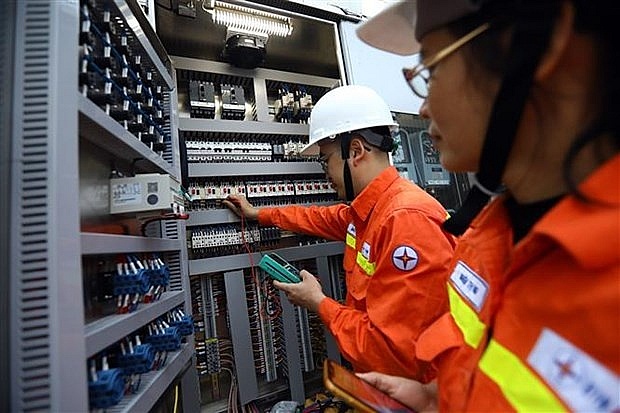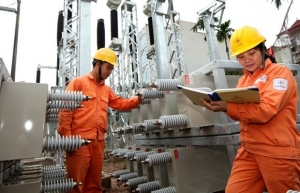More options looked at for energy-efficiency goals
Two weeks ago, the government held a forum to help make the first steps to shape the market of high-efficiency energy-consuming equipment by 2030. The move is made amid the rising pressure to alleviate power outages and achieve the net-zero goal by 2050.
 |
| More options looked at for energy-efficiency goals, photo VNA |
The event, on developing the high-efficiency energy-consuming market from policy to implementation, was organised by the Office of the Steering Committee for Energy Efficiency under the Ministry of Industry and Trade (MoIT).
One measure discussed was promoting the use of high-efficiency energy-consuming equipment and gradually eliminating outdated technological products. Meanwhile, low-efficiency energy-consuming equipment such as storage water heaters and infrared hobs is prohibited to import, produce, and sell in Vietnam, according to a decision made in May.
Dang Hai Dung, deputy chief of the Office of Sustainable Production and Consumption under the MoIT said, “The ministry has oriented a synchronous implementation of technical standards and technology. Following this direction, energy efficiency and technology standards need to be revised, updated, and improved in line with the level of technological development locally, thereby keeping up with regional and world standards.”
The government wants to achieve 8-10 per cent energy savings of total national energy consumption by 2030.
According to the MoIT, one of the key tasks set by the government is an energy efficiency conversion programme of vehicles and energy-using equipment. The goal is that by 2030, Vietnam will save cumulative consumption of about VND10 trillion ($480 million), equivalent to reducing 34 million tonnes of carbon emissions. This means saving about 6,000GWh/year, equivalent to two 500MW coal-fired power plants.
“Commitments to reduce emissions are having an impact on industrial enterprises, including foreign-led ones,” commented Ma Khai Hien, vice director of the Energy Conservation Research and Development Center.
“Currently, energy demand and consumption in Vietnam’s industrial sector accounts for 54 per cent of total national energy consumption, with an increasing trend continuing until 2030. Businesses can use greenhouse gas inventory measures and energy efficiency conversions to save energy and reduce emissions. Only then can they meet the suitable requirements for global trade,” Hien said.
He further suggested that Vietnamese companies can seek financial support from international financial organisations and green finance funds in the global market.
Vietnam has been implementing energy saving solutions for more than 10 years. Nguyen Thi Lam Giang, former deputy director in charge of the MoIT’s Department of Energy Saving and Sustainable Development said that most of the tactics have been management solutions or actions that do not require investment, or require low investment levels.
“Given that industrial firms lack financial resources, it is hard to implement solutions requiring large investments and technology conversion to save energy. It is not easy for firms to access loans from the commercial banking sector because these projects are often evaluated as high risk,” Giang said.
It is hoped that MoIT support will partly promote investment in Vietnam’s energy efficiency market. Do Thanh Thang, power and grid sales director of Schneider Electric Vietnam, said, “Enterprises need clear policies and roadmaps for developing the high-efficiency energy market. To meet market demand, businesses need to continuously innovate and introduce new energy-saving products at a reasonable price while optimising the production process to save energy.”
 | Detailed implementation will direct success of PDP8 Emphasis is being made that the implementation of the nation’s power plan for the decade and beyond will not be successful without a detailed plan and clear investor selection process. |
What the stars mean:
★ Poor ★ ★ Promising ★★★ Good ★★★★ Very good ★★★★★ Exceptional
 Tag:
Tag:
Related Contents
Latest News
More News
- Heavy industries set for pilot greenhouse gas quotas (December 25, 2025 | 10:00)
- Swedfund invests in MSME growth and climate action in Vietnam (December 19, 2025 | 11:42)
- GreenYellow brings solar energy to light up remote schools in Tuyen Quang province (December 19, 2025 | 08:00)
- Charge+, Grab partner to develop EV charging network in Vietnam (December 18, 2025 | 17:11)
- Linking sci-tech and innovation to Vietnam’s net-zero future (December 18, 2025 | 14:31)
- Driving double-digit growth through green and circular transformation in Vietnam (December 17, 2025 | 09:00)
- Standard Chartered and ACCA deepen collaboration to develop Vietnam’s talent for a sustainable future (December 15, 2025 | 18:18)
- Schaeffler reports strong early output from Dong Nai solar project (December 12, 2025 | 15:16)
- Forestry conference highlights biodiversity and sustainability goals (December 09, 2025 | 13:35)
- Home Credit honoured among top 10 sustainable companies in trade and services (December 09, 2025 | 12:18)





















 Mobile Version
Mobile Version